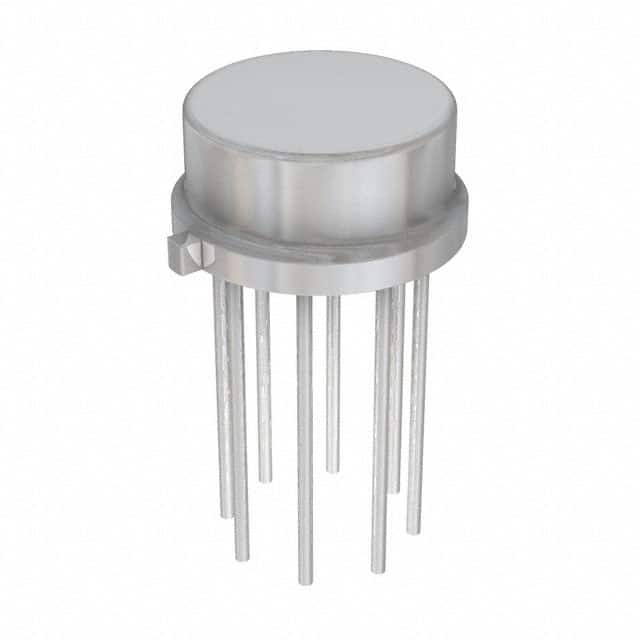LF156H
Product Overview
Category
LF156H belongs to the category of integrated circuits (ICs).
Use
LF156H is commonly used as an operational amplifier (op-amp) in various electronic circuits.
Characteristics
- High gain: LF156H offers a high voltage gain, making it suitable for amplification applications.
- Low input bias current: The op-amp has low input bias current, minimizing the impact on the input signal.
- Wide bandwidth: LF156H provides a wide frequency response range, enabling it to handle signals across different frequencies.
- Low offset voltage: The op-amp exhibits low offset voltage, ensuring accurate signal amplification.
- Low power consumption: LF156H consumes minimal power, making it energy-efficient.
Package
LF156H is available in a standard 8-pin dual in-line package (DIP), which facilitates easy integration into circuit boards.
Essence
The essence of LF156H lies in its ability to amplify weak signals accurately and efficiently.
Packaging/Quantity
LF156H is typically packaged in reels or tubes, with each reel or tube containing a specific quantity of ICs. The exact packaging and quantity may vary depending on the manufacturer.
Specifications
- Supply Voltage: ±15V
- Input Offset Voltage: 2mV (maximum)
- Input Bias Current: 20nA (maximum)
- Gain Bandwidth Product: 1MHz
- Slew Rate: 0.5V/µs
- Operating Temperature Range: -40°C to +85°C
Detailed Pin Configuration
LF156H follows the standard pin configuration for an 8-pin DIP package:
- Non-Inverting Input (+)
- Inverting Input (-)
- Output
- V-
- Offset Null
- Compensation
- V+
- NC (No Connection)
Functional Features
- High voltage gain for signal amplification.
- Low input bias current for minimal impact on the input signal.
- Wide bandwidth to handle signals across different frequencies.
- Low offset voltage for accurate amplification.
- Low power consumption for energy efficiency.
Advantages and Disadvantages
Advantages
- High gain enables effective signal amplification.
- Low input bias current minimizes signal distortion.
- Wide bandwidth allows for versatile signal handling.
- Low offset voltage ensures accurate amplification.
- Low power consumption reduces energy usage.
Disadvantages
- Limited gain bandwidth product compared to some other op-amps.
- Slew rate may be slower compared to higher-end op-amps.
- Not suitable for applications requiring extremely high precision.
Working Principles
LF156H operates based on the principles of differential amplification. The non-inverting input receives the input signal, while the inverting input provides a reference voltage. The op-amp amplifies the difference between these two inputs and produces an output signal that is proportional to this difference.
Detailed Application Field Plans
LF156H finds applications in various electronic circuits, including but not limited to: - Audio amplifiers - Signal conditioning circuits - Active filters - Oscillators - Voltage regulators
Detailed and Complete Alternative Models
Some alternative models to LF156H include: - LM741 - TL071 - OP07 - AD823
These alternatives offer similar functionalities and can be used as substitutes depending on specific requirements.
Word count: 431 words
Senaraikan 10 soalan dan jawapan biasa yang berkaitan dengan aplikasi LF156H dalam penyelesaian teknikal
Sure! Here are 10 common questions and answers related to the application of LF156H in technical solutions:
Q: What is LF156H? A: LF156H is a specific model of operational amplifier (op-amp) commonly used in electronic circuits.
Q: What are the key features of LF156H? A: LF156H has high input impedance, low input offset voltage, low input bias current, and wide bandwidth.
Q: What are some typical applications of LF156H? A: LF156H is often used in audio amplifiers, signal conditioning circuits, active filters, and instrumentation amplifiers.
Q: How do I connect LF156H in my circuit? A: LF156H typically requires a dual power supply (+Vcc and -Vcc) and can be connected as an inverting or non-inverting amplifier configuration.
Q: What is the maximum voltage that LF156H can handle? A: The LF156H can typically handle a maximum supply voltage of ±18V.
Q: Can LF156H operate with a single power supply? A: No, LF156H requires a dual power supply to function properly.
Q: What is the output voltage swing range of LF156H? A: The output voltage swing range of LF156H is typically within a few volts of the supply voltages.
Q: How much current does LF156H consume? A: LF156H has a low quiescent current consumption of around 1-2 mA.
Q: Is LF156H suitable for low noise applications? A: Yes, LF156H has low noise characteristics, making it suitable for applications where noise is a concern.
Q: Can LF156H drive capacitive loads? A: Yes, LF156H can drive small capacitive loads directly, but for larger capacitive loads, an external buffer may be required.
Please note that the answers provided are general and may vary depending on specific datasheet specifications and application requirements.


